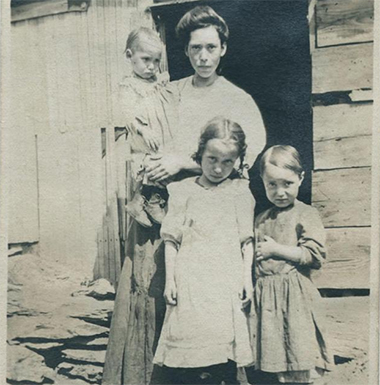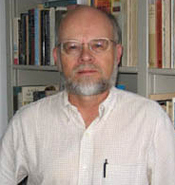Pseudoscientific Injustice
 |
|
Members of the Van Guilder family, outside their home in "Nam" Hollow. |
ALBANY, N.Y. (May 3, 2018) — As sociocultural anthropologist Robert Jarvenpa set off on a notable research career at UAlbany in the early 1970s, living among and documenting Circumpolar hunter-gatherer, herder, and agrarian societies, he began looking at an indigenous culture closer to his new home: the Mohicans.
A side interest in criminology took him to the writings of Arthur H. Estabrook, a eugenicist whose papers are housed in the University Libraries’ Special Collections and Archives. “I sensed that there was an important story about eugenics and Mohican history buried in this archival material,” said Jarvenpa.
He would not get to work on that story, however, until achieving emeritus status in 2011.
The result is the just released Declared Defective: Native Americans, Eugenics, and the Myth of Nam Hollow (University of Nebraska Press), an anthropological history of an outcaste community as well as a critical reevaluation of Estabrook and Charles Davenport’s 1912 work, The Nam Family. The two biologists, leaders of the early 20th century eugenics movement, studied the Nams’ rural enclave within the Washington County towns of Granville and Hartford and were repulsed by the poverty and behavior of the people.
Their conclusion was that what they saw as the family’s indolence, feeble-mindedness, licentiousness, alcoholism and criminality was unavoidably genetic.
 |
|
Author Robert Jarvenpa |
“What Estabrook and Davenport called ‘cacogenics’ — meaning, caused by bad genes or bad germ plasm — was an unfounded assumption or hypothesis that the behaviors they observed were biologically inherited,” said Jarvenpa. “Their methodology, based on genealogies and limited field observations, simply did not permit rigorous or adequate assessment of the complex historical and cultural factors contributing to the Nams' marginalization as a mixed-race outcast community.”
What Declared Defective asserts to the contrary is that Guilder (Nam) Hollow was actually a community of marginalized, mixed-race Native Americans, the Van Guilders, adapting to scarce resources during an era of tumultuous political and economic change.
“Their Mohican ancestors had lost lands and been displaced from the frontiers of colonial expansion in western Massachusetts in the late 18th century,” said Jarvenpa. “Estabrook and Davenport’s portrait of innate degeneracy was a grotesque mischaracterization.”
Jarvenpa chronicles the real lives and struggles of the Mohican Van Guilders, who’d been dislocated from western Massachusetts to New York, where they encountered a steady loss of farmland in the 19th century due to expanding market-based agrarian forces.
In response, said Jarvenpa, “the Van Guilders developed a hybridic subculture which was a creative blend of their ancestral Mohican knowledge and lifeways, on the one hand, and the knowledge of the EuroAmerican families with whom they intermarried. Many of their Native American customs, including a mixed hunting-fishing-horticultural livelihood, seasonal nomadism, basket making and peddling, among other things, were mischaracterized by Estabrook and Davenport as evidence of genetic defectiveness.”
What was responsible for the two authors’ pseudoscientific zealotry, which fed the fearmongering of the time, supported by such luminaries as Planned Parenthood founder Margaret Sanger and Chief Justice Oliver Wendell Holmes?
“Progressive Era eugenics regarded with suspicion, if not hostility, those groups and underclasses who were not part of mainstream Anglo-American society and were, allegedly, spreading defective genes into the mainstream population,” said Jarvenpa. “They pre-judged miscegenation as a biologically degenerative condition, while ignoring — willfully or otherwise — the political economic factors contributing to poverty and marginalization.”
“In targeting mixed-race outcast communities like the Van Guilders, however, eugenicists often confused or conflated socioeconomic class — as in marginalized poor classes — with biology.”
Declared Defective‘s focus ends at the publishing of The Nam Family. Today, Guilder Hollow is a quiet rural neighborhood where some descendants of the original Van Guilder settlers remain, but most have long since dispersed and blended into the general population.
Jarvenpa said he hopes to build upon this line of ethnohistorical investigation in the future, including “some follow-up research on the fate of those people from Guilder Hollow who ‘went west’ and migrated to Minnesota and other places after the Civil War.”
![]() For more news, subscribe to UAlbany's RSS headline feeds
For more news, subscribe to UAlbany's RSS headline feeds
A comprehensive public research university, the University at Albany-SUNY offers more than 120 undergraduate majors and minors and 125 master's, doctoral and graduate certificate programs. UAlbany is a leader among all New York State colleges and universities in such diverse fields as atmospheric and environmental sciences, business, education, public health,health sciences, criminal justice, emergency preparedness, engineering and applied sciences, informatics, public administration, social welfare and sociology, taught by an extensive roster of faculty experts. It also offers expanded academic and research opportunities for students through an affiliation with Albany Law School. With a curriculum enhanced by 600 study-abroad opportunities, UAlbany launches great careers.


